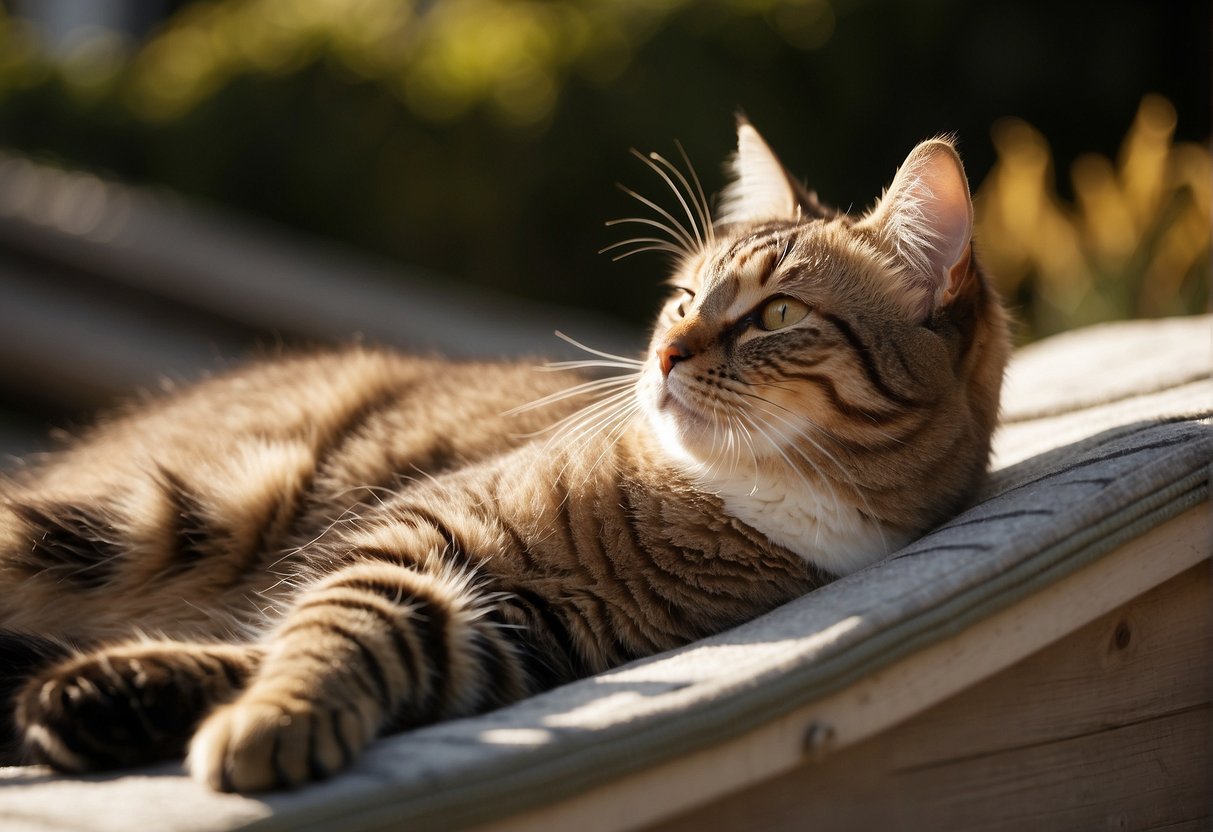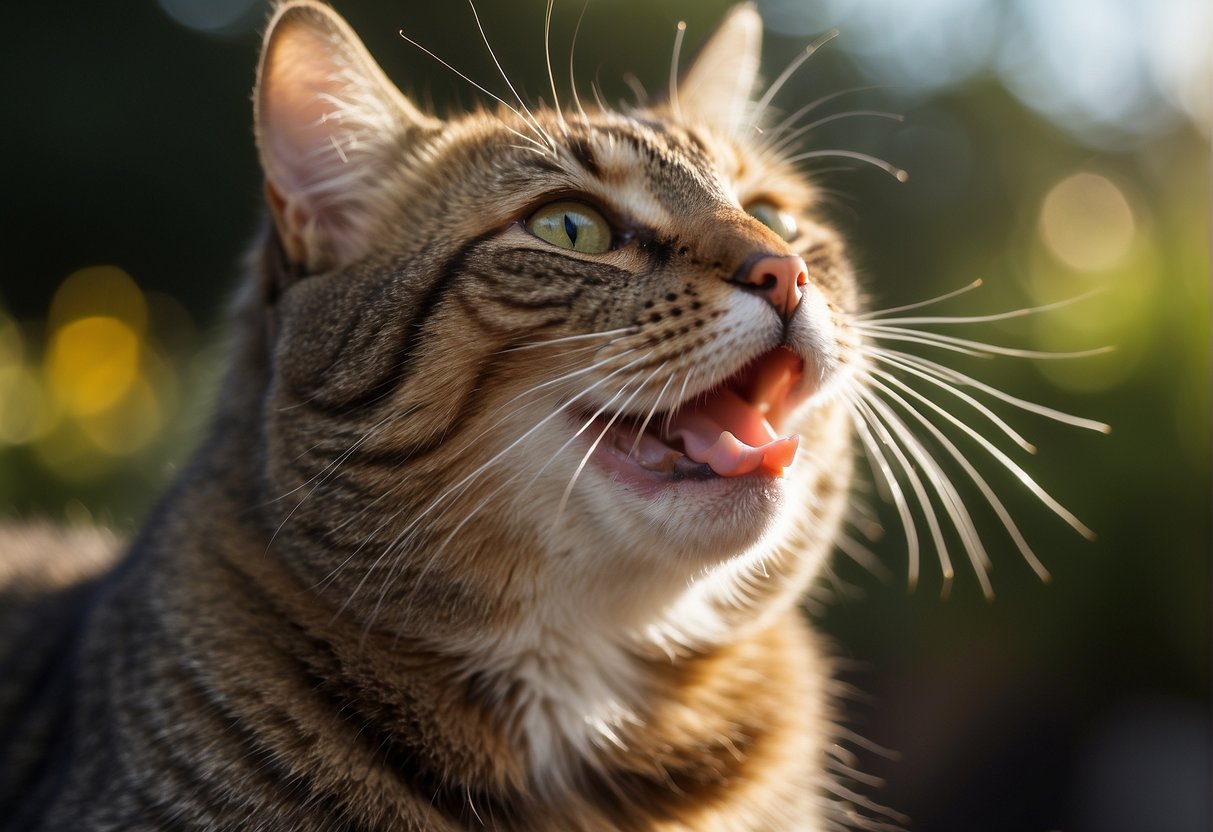Cats do indeed sweat, though not as visibly or as profusely as humans do. Your feline friend maintains a stable body temperature through a few sweat glands located in specific areas of their body, namely their paw pads.
On a hot day or when they’re feeling particularly stressed, you might notice damp little footprints on the floor, indicating their way of cooling down.

Maintaining their body temperature is crucial for cats, and while sweating plays a role, it’s not their primary method of keeping cool.
They are also good at finding the coolest spot in the house to relax or positioning themselves to catch a refreshing breeze. You’ve likely observed your cat sprawling out on the bathroom tiles or pressing against a window to ease the heat, just as they find warm spots to bask when they are cold.
In your journey as a cat owner, providing plenty of fresh water and a comfortable environment will help your cat stay cool, especially during the warmer months. Just like us, our feline companions need to regulate their body temperature for overall health.
Cat Sweat and Body Regulation

When you think about how your feline friend manages to stay cool, you might be surprised to learn that cats do have sweat glands and use them to regulate their body temperature. Now, let’s take a closer look at how this works.
The Biology of Cat Sweat Glands
Your cat’s sweat glands are located primarily in their paw pads. Unlike humans, cats don’t have these glands all over their body. These glands are part of what keeps your pet from overheating.
When the temperature rises, these glands become active and excrete moisture that, when evaporated, helps to cool down the surface of their skin.
While these glands are small in size, they play a significant role in helping your cat to regulate body temperature, especially since the rest of their body is covered with fur, which provides insulation but is not ideal for sweating.
How Cats Cool Down on Hot Days
On those especially warm days, you’ve probably noticed your cat seeking a cool tile floor or a shady spot. That’s because, in addition to using their paw pad glands, cats employ other methods to cool down.
For instance, they’ll find a cool surface area to lie on, maximizing the contact of their hairless areas like their belly and the inside of their legs. Panting is another way that cats can dissipate heat, though it’s less common than in dogs and often a sign your cat is quite hot.
If you observe excessive panting, it’s a good idea to help your cat cool off more effectively, as they could be at risk for heat stroke. Evaporation plays a vital role in temperature regulation, and you can assist by ensuring they always have access to cool water and shaded areas.
Cat Cooling Behaviors and Habits
Cats have developed several adaptive behaviors to regulate their body temperature during hot conditions. It’s important to understand how your feline friends keep themselves cool and to ensure they have the means to do so.
Grooming and Its Role in Cooling
Regular grooming is more than just keeping up with appearances; it’s a crucial self-cooling behavior. When cats groom, they spread their saliva over their fur.
As the saliva evaporates, it helps lower their body temperature, much like the effect of sweat evaporating off human skin. During those sweltering summer days, you might notice your cat licking its coat more frequently—this is their way of coping with the heat.
Seeking Shade and The Right Environment
Your cat instinctively knows that cooler areas are the key to comfort when it’s hot. Seeking out a shady spot or a shady area, whether it’s under a bush outdoors or a cool tile floor indoors, is a common behavior.
Cats often prefer these locations for their siesta, the short nap they enjoy, especially during the warmest part of the day. Provide accessible hideouts where they can escape the sun’s intensity.
- Play: Limit vigorous play to cooler periods like early morning or late evening
- Environment: Set up comfortable resting places away from direct sunlight
Drinking and Water-Related Activities
Hydration is vital for temperature regulation. Making sure your cat has constant access to fresh water can go a long way.
Cats may not only drink the water but sometimes dip their paws into the water bowl, leaving behind wet paw prints as a sign they’re trying to cool down. To encourage drinking, place several water bowls around, especially in cooler areas where your cat likes to relax.
Responses to Heat and Signs of Distress
When your cat is exposed to high temperatures or stressed, it’s crucial to recognize the subtle clues they give to avoid serious complications like heatstroke. Knowing what to watch for can help keep your kitty comfortable and healthy.
Drooling, Panting, and Other Heat Stress Signals
Cats handle heat differently than humans do. While they don’t sweat all over their bodies the way we do, they might exhibit a few key indicators of heat stress that you should be aware of:
- Panting: Unlike dogs, it’s uncommon for cats to pant. If you see your cat panting, they may be trying to cool down and could be at risk for overheating.
- Drooling: Excessive drooling can be a sign of heat stress or anxiety in your cat.
- Resting and Lethargy: If your furry friend is lying around more than usual, heat may be affecting their energy levels.
- Disorientation: Confusion or odd behavior can indicate your cat is experiencing too much heat.
Additionally, keep an eye out for signs of respiratory distress, diarrhea, or odd odors, as these can also indicate your cat may be stressed or overheating.
Recognizing and Preventing Heat Stroke in Cats
Heatstroke can be fatal and requires immediate attention. Here are signs that may suggest your cat is experiencing heatstroke, along with tips to prevent it:
- Signs of Heatstroke:
- Rapid breathing or gasping for air
- Bright red gums
- Vomiting and diarrhea
- Seizures or trembling
If you notice any of these symptoms, it’s essential to take immediate action by moving your cat to a cooler environment, offering water, and contacting your vet.
- Prevention Tips:
- Ensure your home is well-ventilated; use an air conditioner or fan if available.
- Provide a shady, cool place for your cat to rest away from direct sunlight.
- Watch for heat waves and prepare by keeping your home cooler and limiting exercise during the hottest parts of the day.
Maintaining a Healthy Environment for Cats
Creating a haven for your feline friend is essential for their health and happiness. At the heart of this sanctuary is the understanding that your cat’s comfort and well-being stem from a balance of hydration, nutrition, and a stable, supportive environment.
Adequate Hydration and Dietary Measures
Hydration is the cornerstone of a healthy environment for any domestic cat. It keeps their body temperature regulated, especially during the warmer months. Here’s how you can ensure your cat stays well-hydrated:
- Access to Fresh Water: Always have fresh water available. Consider a cat water fountain as cats often prefer running water.
- Wet Food: Incorporate wet food into their diet, which can provide additional moisture.
Dietary needs also play a pivotal role in your cat’s overall health:
- Quality Food: Ensure their food is high in protein and low in grains to match a cat’s natural dietary needs.
- Regular Mealtimes: Stick to a consistent feeding schedule to help manage their energy levels and digestion.
Additionally, you can keep your cat cool with these simple tactics:
- Ice Cubes in Water: Drop a few ice cubes in their water bowl for a refreshing drink.
- Ice Pack: Place an ice pack wrapped in a towel in their favorite resting spot.
Physical and mental exercise helps maintain a healthy weight and reduces anxiety and restlessness. Engage in regular play sessions to encourage activity and stave off boredom.
Veterinary Care is essential. Regular check-ups with a veterinarian can help you manage and prevent potential issues related to hydration, nutrition, exercise, anxiety, pain, or skin problems.
In the case of long-haired breeds like Persians, overheating can be a concern, so always monitor their activity and encourage them to cool down after play.

My name is James, and welcome to FAQCats!
Along with our team of cat owners, expert pet enthusiasts, and pet professionals, we aim to write engaging helpful, engaging content about cats. At FAQCats we strive to provide content that’s accurate and fun to read. Our team writes about everything related to cats; even the most complex of topics. Through extensive research and caring for our own fur-pals, we’re able to provide something cat owners worldwide will love. Have a look around, and leave us feedback anytime!

